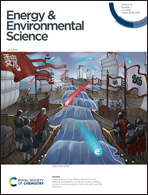Advanced in situ technology for Li/Na metal anodes: an in-depth mechanistic understanding†
Abstract
Li/Na metal anodes, based on their high theoretical capacity and low electrochemical potential, provide promising alternatives for next-generation high energy batteries. However, their unstable solid–electrolyte interphase and dendrite growth remain ubiquitous issues that have led to the decline of cycle performance and even safety problems. In the past 5 years, research interest and achievements in in situ technologies have surged globally, including in situ reactions to form a specific interface layer and in situ characterization to capture transient metastable information of metal anodes continuously as a function of time. It is desirable to provide an overview with a comprehensive understanding of the reaction process, degradation mechanism and structure evolution of metallic Li/Na through advanced in situ techniques. A critical appraisal of recent advances in the in situ technology is also presented for addressing the key issues in metallic Li/Na anodes, with a special emphasis on the emerging in situ electrode design and advanced in situ electrochemistry mechanism analysis. Finally, we provide a roadmap regarding the remaining challenges and integrated improvement strategies toward next-generation reliable and stable metal anodes.

- This article is part of the themed collection: Energy and Environmental Science Recent Review Articles


 Please wait while we load your content...
Please wait while we load your content...